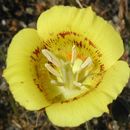en
names in breadcrumbs


This California endemic occurs in the coastal counties from Humboldt to Ventura. Inland it is found from Tehama County (Payne's Creek and Dye Creek watersheds) southward through the Sierra Nevada Foothills and Sacramento Valley as far south as the Greenhorn Mountains of Kern County; moreover, it is found at the Channel Islands National Park
C. luteus thrives in sandy or loamy soils which are well drained, and is highly adaptable to variable pH ranges spanning alkali to acidic regimes. This species is drought tolerant, but does not thrive in deeply shaded conditions. Yellow Mariposa Lily (also known by the common name Gold Nuggets) may be found at elevations under 600 meters in coastal prairie, grassland, oak savanna, mixed oak woodland and mixed-evergreen forest. C luteus thrives in many of the same sun drenched rocky habitats as C. venustus. Typical dominant oaks in the overstory of forest clearings and savanna include Blue Oak, Quercus douglasii. (Hogan).
The plant exhibits a slender stem emanating from a base bulblet, that attains a height of 20 to 50 centimeters (cm).The basal leaves are persistent and extend from 10 to 20 cm. There are one to seven bowl shaped flowers per plant, with bracts that reach one to eight cm. Petals open wide in the daytime and enclose when light intensity lessens in the late afternoon. There are three long narrow tapered sepals two to three cm wide, and may be straight, recurved or coiled; the three deep yellow petals are each 2.5 to 5 cm wide. Each petal has red stippling below, with individual variation comprising endless patterns. Petals are fan shaped at the tip. Pale yellow anthers are eight to ten mm in extent. The oblong to crescent shaped nectary is coated with sparse short slender hairs. This nectary is the best diagnostic to distinguish C. superba, which has a squarish nectary geometry. A red-brown blotch usually is present near the inside center of each petal. Fruits are erect, three to six cm, and their shape is angled and narrowly lanceolate.
David Douglas was the first person to collect and name C. luteus, although John Lindley initially described the species in 1834. Historically the name Calochortus luteus was later applied by Nuttall to the species C. nuttallii, but that species name was changed in 1852 by John Torrey, since the species name C. luteus had been originally coined by Douglas. C. luteus hybridizes in the wild with C. superbus.
Calochortus luteus, the yellow mariposa lily, is a mariposa lily endemic to California.[2][1]
The primarily bright deep yellow flower is 3–5 cm across and perianth bulb-shaped, lined red-brown inside, often also with central red-brown blotch and sparse hair inside.[3][4][5] It is a perennial herb.[6]
This species is found on coastal prairie, grasslands and some open forest floors.[7] Its range is along the coastal ranges from region to the northern Santa Barbara County Channel Islands and mainland, Northwestern California, the Sacramento Valley, and the Sierra Nevada foothills from there to the Tehachapi Mountains.
Calochortus luteus is used in landscape design, with "non-habitat sourced" bulbs available from native plant nurseries and societies, to grow as an ornamental plant in gardens and for restoration projects.[8][9]
Calochortus luteus, the yellow mariposa lily, is a mariposa lily endemic to California.